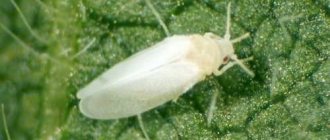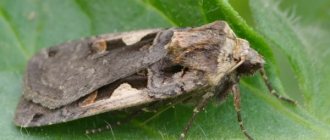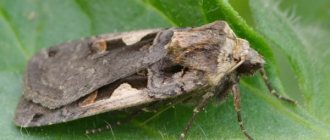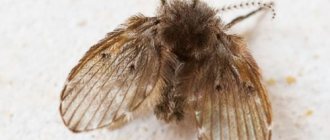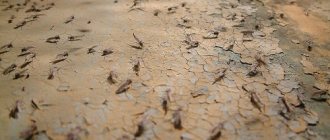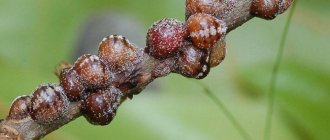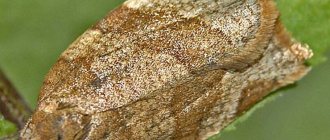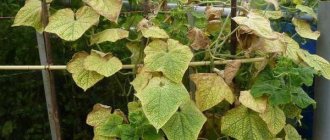Why do midges appear on tomatoes?
When small midges appear on tomatoes, it is necessary to react as quickly as possible and take measures to destroy the pest. These insects appear and also actively spread in high humidity and extreme heat. This environment is created by inexperienced gardeners or in a greenhouse.
Black and white insects cause equally great damage to plants; in addition, they are quite difficult to fight, especially in advanced cases.
The midge reproduces incredibly quickly, it attacks all the green parts of the plant, sucking the juices out of it, and having destroyed one bush, it immediately moves to the next. There are several varieties of this pest, but all belong to the same species - aphids.
Who are black midges
Black midges on tomatoes are dacha, or tomato, aphids, of which there are many varieties (several thousand species), they can be with or without transparent wings.
But all species equally pose a danger to the future harvest. These small insects, only 1-2 mm long, reproduce very quickly; in one summer they can grow from 2 to 5 generations.
In autumn, females lay eggs, which remain viable even at sub-zero air temperatures. In the spring, the eggs hatch into larvae, they grow quickly, turn into adults and begin to reproduce by parthenogenesis, that is, without fertilization. And literally in one month their number can reach several hundred thousand.
You may not notice the midges right away, as they settle on the inside of the leaves. Having destroyed one bush, the midges fly or move to other tomatoes.
Types and signs of parasitism
Small insects can cause irreparable damage to crops both outdoors and in the greenhouse. You should inspect the plants daily, paying especially close attention to young seedlings, which quickly die when attacked by midges of any variety.
On tomatoes, two similar species are most often found - white aphids and black aphids. They differ in color and body structure, but they cause equally strong damage. To determine the infestation and take action in time, the easiest way is to shake the tomato bush, then the midge will fly into the air.
White midges whiteflies
On the bottom of the leaf it is easy to notice small white flies - these are whiteflies. They have transparent wings, the body is less than 3 mm. These insects jump and fly well, so they quickly infect plantings.
Most often this pest appears in greenhouses, although it is also found in open plantings. Like other types of aphids, the whitefly sucks the juices from the plant, resulting in curling of the leaves, drying out of individual parts, falling flowers, or the absence of ovaries on tomatoes altogether. In addition, black or brown spots appear.
Black
Black midges on tomatoes are common and multiply incredibly quickly. Tomato aphids are a little different, as there are many varieties. Regardless of the presence of wings or size, the insect quickly destroys the plantings and the plants die.
Dark midges are much smaller, their body grows no more than 2 mm in length, and up to 5 generations of insects are born in one season. Aphids lay eggs for the winter in old bark, foliage, and other secluded places. At the same time, they are not afraid of frost. In the spring, larvae hatch from the clutch, develop quickly, and reproduce without fertilization at high speed.
Methods of protection against pests
Regardless of what type of midges attacked the tomatoes, they must be fought in every possible way. Large-scale damage will most likely require the use of chemicals. However, during the flowering and fruiting period, it is better to give preference to folk remedies.
Effective insecticides and treatment procedures
Chemical treatments for garden pests include mild pesticides and organic insecticides. You can purchase them at any specialized store. Safe products are those drugs based on fatty acids, vegetable oils and pyrethrins.
Actofit is a liquid remedy against various types of insects
Use against black midge:
- Actofit is a liquid remedy against various types of insects, including midges. The drug is diluted in different doses, making three solutions. You can add soap to each so that the product lingers longer on the foliage. After treating different bushes, they look at how the midges reacted. The dose that killed them almost completely is considered the most effective. Actofit works at an air temperature of at least 20 degrees. Repeated treatment is carried out after two weeks;
- Fufanon - for spraying tomatoes, a certain dose of the drug is diluted in a liter of water. Treatment is carried out three times a year: in the spring, a few weeks after planting or germination, at the end of June and in mid-August. The interval between each procedure is about a month;
- Aktaru - the product is available in the form of granules or liquid concentrate. The dosage is 10 ml of chemical per bucket of water. The solution is watered into the soil during the fruiting period or sprayed when insects are present. The product is valid for approximately two weeks.
Chemicals should not be used when tomatoes have already begun to ripen. It is advisable to perform any treatment twice a day, before sunrise and after sunset. In rainy weather, it is better to refuse the procedure, because... the effectiveness of the drugs will decrease significantly.
Folk remedies
If the number of small midges on tomatoes has not yet increased to a critical level, then treatment can begin with the use of folk remedies. They are safer, but no less effective. The most powerful home remedies are:
- soap and wood ash. 20 g of soap shavings are diluted in 10 liters of warm water and mixed with 250 g of wood ash. Treat the bushes in the morning and evening;
- vinegar solution. A tablespoon of 9% acid is dissolved in a liter of water and sprayed on tomato bushes;
- garlic, pepper, mustard. Chop two heads of garlic, add 2 tablespoons of red pepper and 6 tablespoons of mustard powder. All this is poured with a bucket of hot water and left for up to three days. After this, the tomato leaves are moistened, paying special attention to the lower part of the bush.
Home remedies to combat midges will help at the very beginning of their appearance. If the pest has multiplied in almost all plantings, then it is better to use chemicals.
To combat midges, use an infusion of garlic, pepper and mustard
How to distinguish from a tomato mosquito?
You should get rid of pests immediately, but first of all, you need to determine exactly who is spoiling the crop. The tomato mosquito is very similar to the winged aphid, but it does a little less harm. The main difference between pests is the breeding season. The mosquito most often attacks seedlings, since it appears precisely during this period of time, while aphids hatch during the flowering period.
The mosquito is twice as large as the aphid; it damages the plant in a similar way, drinking the juice, but prefers to start from the top of the bush . The mosquito larvae are located in the ground, and therefore can damage the tomato from the root, especially if there are a large number of worms reaching 8 mm in length. They feed on roots, and therefore it is important to be more careful.
When the tomato has grown, the roots have become stronger, the tomato mosquito will not cause much harm to the plant, however, it is necessary to control the insect population, no matter what, because it is a pest.
How dangerous are insects?
In addition to the fact that black flies on tomatoes in a greenhouse or open ground are capable of sucking out all the juices, curling the leaves, and destroying the ovaries, they can infect all plants with other dangerous diseases.
Young plants are most susceptible to attack; they have not yet grown strong, and the roots have not gained strength. Fungal and bacterial infections, along with aphids, will completely destroy the plant.
Parasites are dangerous for tomatoes not only in adulthood. At the larval stage, they secrete a sticky, waxy liquid that prevents the plant from developing normally. As a result, it becomes more difficult to control aphids.
For an adult, strong tomato bush, aphids are not so terrible; it is difficult for the insect to bite through the hardened parts of the plant. However, mature fruits may suffer and develop unsightly black spots caused by insect waste.
Who are white midges
White midges on tomatoes are simply called whiteflies. They are very similar to small moths, only 3 mm long, with 4 transparent wings. White midges, like black ones, live on the back side of the leaf, but they fly and jump well.
Most often, whiteflies infest tomatoes in greenhouses, but they can also damage bushes in open soil. The method of reproduction of both white and black midges is almost the same, since they all belong to parasites - pests - aphids.
How to deal with the pest?
It’s easy to defeat the pest at home; the main thing is to do the procedure in a timely manner, treat all parts of the plant, not only the foliage, but also the trunk. For a greenhouse, control methods are practically the same.
Chemicals
The most common chemical control method is spraying. There are a large number of different drugs that will help cope with black aphids. You need to spray tomatoes against black midges according to the instructions on the packaging, which are present on any preparation.
Systemic chemical products will be most effective; it is best to use enteric contact agents Aktaru and Decis.
Specialized means
Insect control can be more severe or using gentle insecticides of organic origin. To treat tomatoes, preparations based on vegetable oils and acids are used. The most popular among them are Fitoverm, Aktafit.
When handling, it is important to strictly follow safety precautions by wearing gloves and a respirator. Repeat spraying twice, taking weekly breaks between them. During the tomato ripening period, the plants are not treated with chemicals.
Folk recipes
If time is not lost, the aphids have not spread much on the plants, then folk remedies may well help. The treatment will have to be carried out several times, but this will protect the future harvest from the effects of chemicals.
- Treatment with soap and ash are the most universal methods of combating aphids. To do this, you need to dissolve 20 g of laundry soap shavings and ¼ kg of tree ash in a bucket of warm water. Then thoroughly spray with this solution, even rinse individual areas of the plants.
- If you dissolve 1 tbsp. l. table vinegar 9% in a liter of water, you will also get a good solution for fighting insects on tomatoes.
- The following composition is infused for about three days: dissolve 2 tbsp in a bucket of hot water. l. red chili pepper, 6 tbsp. l. dry mustard, two chopped heads of garlic. This method involves bathing tomato tops in a solution; it is especially important to treat the lower part of the plants.
- Taking 4 kg of celandine branches, you need to fill them with a bucket of water, leave for a day, then bring to a boil, steam over low heat for half an hour. Strain the mixture, dilute 1 liter of decoction with 10 liters of water. After another two days, spray the diseased plants; repeat only after a week.
Long-term preparation of folk remedies leads to the fact that during this period the pests spread greatly. Preference should be given to quick ways to solve the problem.
Fumigation of greenhouses
Fumigation can only be done in a greenhouse; this method will not give results in the fresh air. Sulfur is used for combustion; 1 m3 requires 200 g of dry matter. After the procedure, the greenhouse must be closed for at least 4 days. Not only the aphid dies, but also the tomato mosquito. Carry out processing strictly after harvesting.
Biological drugs
Treatment with biological agents is safe for humans, but the result of exposure is somewhat different. One important condition distinguishes them from chemical ones - that it is permissible to pick and eat the fruits after treatment after 2 days. Also, biological products are harmless to animals and bees. The maximum result of their use will be visible after a week.
Entobacterin helps destroy insects at high air temperatures, which is an advantage for the southern regions of the country. And 50 species of different pests die from its influence. The drug Strela will destroy a large number of pests in just 2 days.
Every year, many different biological products appear that help fight pests.
What herbs will help get rid of parasites?
Treatment will not be useful if you plant the necessary herbs next to the tomatoes that can repel pests. Flowering strongly scented plants such as fennel, peppermint or basil will repel aphids. It is useful to sow garlic or cilantro between rows of tomatoes; marigolds will help in the fight against aphids.
Fighting methods
When there are few black midges on the tomatoes, you can simply crush them with your hands, and then wash the bush with water pressure. However, it is worth taking into account that the surviving pests will rush back to the tomato bushes as quickly as possible.
You can easily get rid of adult insects using a special adhesive tape for flying insects, and a weak solution of vinegar or potassium permanganate will help remove the larvae that live in the upper layer of the earth.
If you sprinkle a little tobacco dust into a container with seedlings, or put cloves of garlic, the smell will repel midges, which means they will not be able to reproduce.
Chemicals
If there are too many black midges, you will have to resort to chemicals, such as pesticides and organic insecticides. Safer preparations for use in gardening are those based on fatty acids, plant oil and pyrethrins. They not only help fight aphids, but also increase plant resistance to disease.
The most effective drugs for combating black midges are: ·
- Fozalon;
- Aktafit;
- Fascord;
- Aktar;
- Benzophosphate;
- Fufanon
Any of these remedies has a fast and strong effect, as well as a long period of protection. Each drug is accompanied by detailed instructions indicating the dosage and method of its use. At least three treatments must be carried out with an interval of approximately 7 days.
Plants are treated early in the morning and always in dry weather.
Some gardeners use sulfur smoke in greenhouses with tomatoes to combat midges. After treatment, the entire population dies, both adults and their eggs. Smoke is obtained by spreading sulfur powder on hot baking sheets.
Chemicals should not be used when tomatoes are ripening; in this case, it is better to resort to safer folk remedies.
Folk remedies
To effectively combat black midges, experienced gardeners use time-tested folk remedies that are not only safe for all plants, but also do not harm human health.
Solutions are prepared with the addition of laundry or any liquid soap for better adhesion to the plant, and any of the following is used as the main component: ·
- ground red pepper;
- mustard powder;
- garlic arrows;
- onion peel;
- ash;
- sagebrush;
- dandelion leaves.
To prepare a potion that is poisonous to midges, you can combine the following ingredients.
Aphids really don’t like a decoction of celandine and wormwood:
- one part of the herb is infused for 20 minutes in two parts of hot water;
- the decoction is diluted 1:10;
- add 20 g of laundry soap; ·
- Tomato plantings are generously sprayed.
The most effective and most common means for combating black midges on tomatoes is a solution of ash and garlic:
- finely chop 7-10 cloves of garlic, add a liter of warm water and leave overnight;
- pour a glass of ash into a bucket of cold water;
- pour in the garlic mass;
- add a little laundry soap or any liquid soap;
- Spray the plants generously.
The prepared solutions are effective until the first watering, then their effectiveness decreases, so treatments will have to be carried out frequently.
Measures to save seedlings
If black midge appears on tomato seedlings, then you urgently need to spray the plants with Proteus. Careful treatment of the bushes with folk remedies will help, this will be an infusion of herbs or tobacco, as well as ash or iodine.
Carefully inspect the area and surrounding area; if you find an anthill, remove it immediately. This can be easily done using boiling water or hot ash. There are many ways to fight ants; it is better to use several of them at the same time.
Interesting! In a greenhouse, the best method is fumigation or mechanical removal (in cases where there are few insects).
Prevention
Pests will appear less often in the garden if you use simple prevention methods:
- regular autumn removal of weeds from the site;
- digging up the earth;
- escape in a greenhouse by fumigation with sulfur;
- removal of anthills;
- attracting ladybugs, wasps;
- attracting birds;
- planting useful plants between tomato rows.
Advice! It is important not to flood the plants, and not to overheat the air in greenhouses.
To preserve the harvest, it is important to regularly inspect the bushes, find pests, and take a responsible approach to their removal. Various preventive measures and therapeutic agents are used to help get rid of black midges or whiteflies on tomatoes.
How to get rid of black midges on tomato seedlings
The black midge is an outdoor pest, but sometimes it appears on seedlings. Insects leak through windows or their larvae already live in the ground. You need to decide what to do if midges appear on the seedlings.
You should not throw away the sprouts; try to save future tomato bushes. Let's look at how to get rid of black midges on seedlings.
Method No. 1
You noticed that a midge is flying over the seedlings. Most likely it is a sciarid or fungus gnat. They are attracted to abundantly moist soil, where insects lay eggs. If you reduce the intensity of watering so that the top layer of soil dries out slightly, you can repel fungus gnats.
The flyers themselves are destroyed using fumigators, adhesive fly tapes or anti-ant drugs. The latter need to be placed between pots with seedlings.
Before carrying out the treatment, make sure that you have harmful sciarids. They are often confused with fruit flies - fruit flies, which are attracted by the smell of overripe fruit or sour jam.
Method No. 2
If the midge has already laid larvae in the soil for seedlings, changing the watering regime will not solve the problem. Tap the container with the seedlings with your hand. Did a flock of insects fly up? Drastic measures are needed to get rid of the masonry. Water the plants with a weak solution of potassium permanganate. And three days later - with water flavored with citric acid and a drop of liquid soap.
Even our grandmothers knew how to treat seedlings against midges. The spread of larvae is prevented by ash, which is sprinkled on the ground for seedlings. Bury a clove of garlic or a pinch of tobacco - their smell repels worms.
Method No. 3
Mild chemicals are another method of treating seedlings. Try the following:
- Fufanon;
- Grom-2;
- Aktara;
- Fly eater.
As a last resort, use Dichlorvos. After treatment, plants are covered with polyethylene and taken out of the living room so as not to harm people.
If there is an abundance of parasites in the soil, the seedlings are replanted, and the damaged soil is thrown away or burned.
Methods for controlling midges are varied. Which one to choose depends on the availability of components and the desire of the gardener. Follow the instructions strictly, and you will save your tomato harvest from annoying insects.
